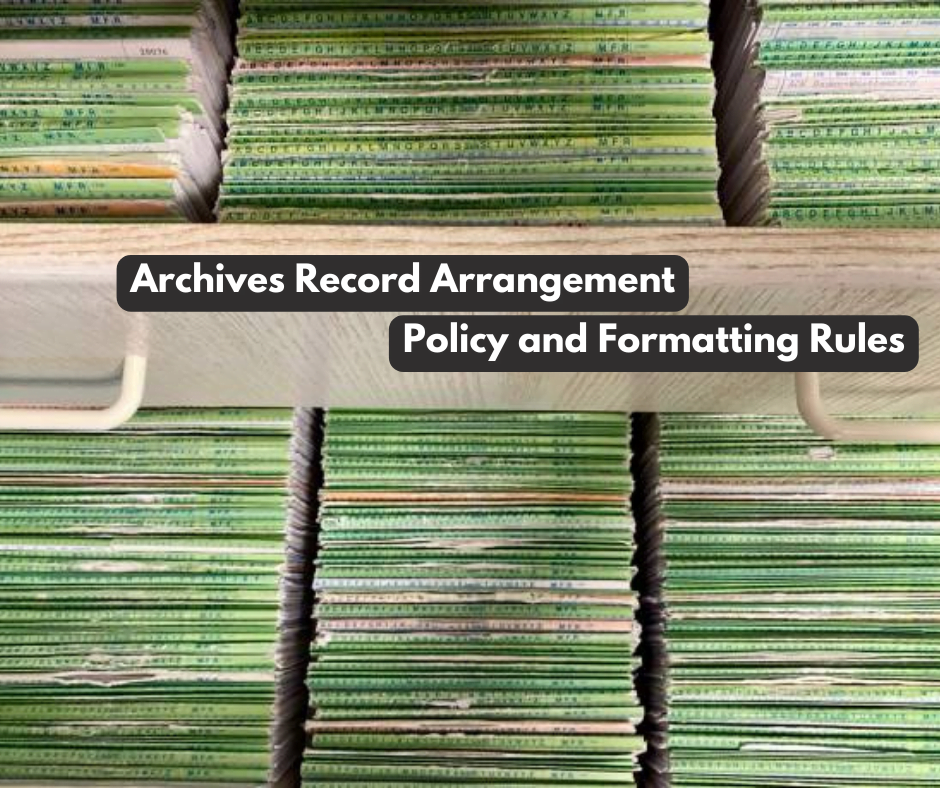The specific rules by which documents stored in archives are arranged are called document sorting rules. Archives records are at least 25 years old and are historical documents. Valuable and obsolete documents from all ministries and departments are stored in the archives. The rules for organizing records in archives are different from the rules for organizing records in government agencies.

Archives Record Arrangement Policy :
Among the various responsibilities of an archivist, the main responsibility is to arrange the documents received from different organizations according to the rules of archives. It is never possible to categorize the documents received in the archives in advance or organize the documents in a planned way. Archive document sorting policies depend on two factors. First, related documents will belong to the same group. Second, individual subjects should also be included in a group. And to make them permanent, the registry system was invented. There are four rules for sorting documents. Any of these should be followed by an archive institution. The rules are:
- Respect des Fonds
- Principles of Provenance
- Archives Groups
- Records Groups
1. Respect des Fonds
On 25 June 1794, the first modern archive in France was established after the French Revolution. Respect des Fonds was established in France in 1841. From 1790 AD to 1880 AD documents were stored by the symbols A to Z, and from 1800 onwards documents were stored according to general subjects such as political, general education, and judicial.
According to the Fond rules, any administrative corporation or any private document is included in the Fonds, divided according to the first subject, and all its documents must be arranged chronologically or geographically or alphabetically according to any of the rules. That is, as per Fonds rules, important documents should be arranged first, then less important documents should be arranged.
Sorting documents through these Fonds is easier than any other rule. The advantage of this system is that documents on the same subject can be easily kept in the same place. These Fonds helps a lot in rearranging documents according to their original order.
2. Principles of Provenance
The Principles of Provenance were first published by Heinrich Van Sybel, Director of the Prussian State Archives (1877–1895), and Max Lehmann (1845–1929). On 1st July 1818, the Prussian State Archives issued the Principles of Provenance. After Max Lehman’s efforts, this rule was introduced in all government offices.
According to the Prussian Principles of Provenance rules, each document is arranged based on the number assigned by the registry department, not by subject. This means that Prussian government documents are controlled by their registry office, and the archive institution maintains the number given by the registry office. This rule is referred to as the Principles of Provenance.
3. Archive Group:
In his Manual of Archive Administration, Sir Hellery Jenkinson provides information about the government reorganization in England known as the Archive Group. According to Jenkinson, documents should be arranged in their original order to clearly show their content. The Archive Group organizes documents by grouping them according to the main subject or series. Related subjects are included in the same series, while minor issues are listed in alphabetical order if they are not included in the main group. When adding new documents, they should be placed in order according to a numbering system or following general rules, and the original file numbers should not be altered. Jenkinson also notes that, in some cases, compromises can be made when dealing with particularly significant documents, but this is a risky and responsible decision for an archivist.
4. Records Groups:
In 1841, America’s first record group, the American National Archives, introduced rules for organizing documents. This record group is used in all government institutions. Record groups are further divided into different subgroups, which are arranged based on the organization and functions of any given organization. These subgroups are matched with specific series, known as file units or volume folders, and individual documents are also kept in sequential order.
Five golden guidelines should be adhered to:
- As a rule, modern records should be kept in separate unit record groups that correspond to their source in a government agency.
- As a rule, the holdings of a National Archives should be subdivided for administration into several units or groups called the archives group, records group, registry group, and Fond what you will.
- As a rule, modern records that are preserved for the evidence they contain of the organization or functions of the agency should be maintained in the order given them by the agencies that created, maintained, or accumulated them.
- As a rule, modern records that are preserved for their information content, without reference to their volume as evidence of the organization or functions of an agency, can be maintained in whatever order will best serve the needs of the scholar. Such records are the result solely of the information they contain on persons, places, or sociological, economic, scientific, or other matters. So such records can be arranged alphabetically, geographically or subject-wise to facilitate their exploitation.
- As a rule, the government agency and their organization make impossible a completely logical arrangement of records by provenance, and a more relaxed system could be resorted to by making a series as a unit of arrangement.
The policy and formatting rules for arranging archival records are essential to ensuring efficient retrieval, preservation, and accessibility of historical documents. These guidelines standardize the organization process, making it easier for users to locate and interpret records. Following defined procedures supports the archival system’s function in preserving an extensive and useful historical record by enhancing its dependability and integrity.



